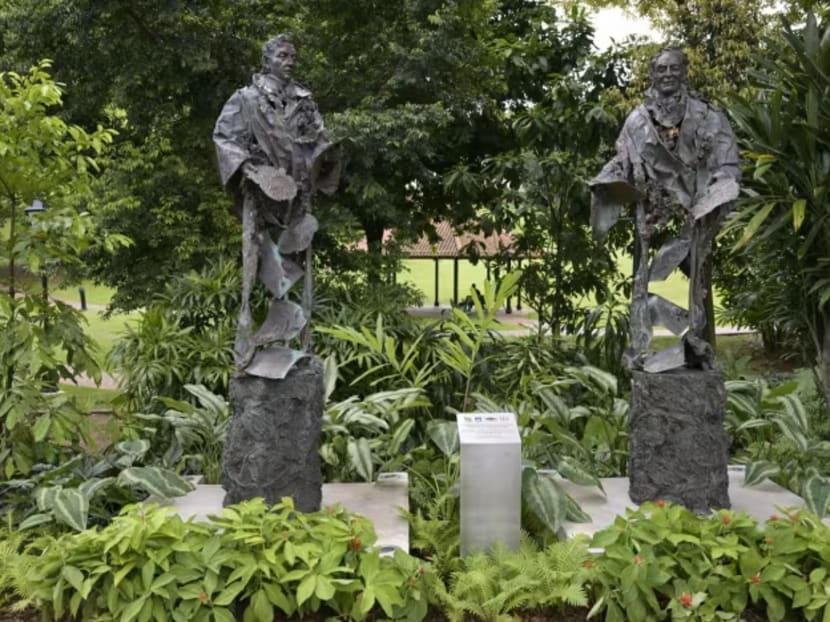Raffles, Wallich statues in Fort Canning: Singapore does not glorify its colonial past, says Desmond Lee
SINGAPORE — Singapore takes a "clear-eyed view" of its colonial past and does not glorify or celebrate it, National Development Minister Desmond Lee said on Tuesday (July 2) about the recently installed statues of Sir Stamford Raffles and Dr Nathaniel Wallich in Fort Canning Park.

The artwork was unveiled on May 21, 2024 at the site of the first botanical and experimental garden established by Sir Stamford Raffles and Danish botanist, Dr Nathaniel Wallich, in Fort Canning Park.

This audio is AI-generated.
SINGAPORE — Singapore takes a "clear-eyed view" of its colonial past and does not glorify or celebrate it, National Development Minister Desmond Lee said on Tuesday (July 2) about the recently installed statues of Sir Stamford Raffles and Dr Nathaniel Wallich in Fort Canning Park.
Nominated Member of Parliament (NMP) Usha Chandradas had asked about the basis for the installation of the statues, given the "more recent trends" towards decolonisation and the "re-examination of colonial histories".
The statues prompted online debate and criticism, with some questioning the installation.
In his written parliamentary answer, Mr Lee said Singapore has charted its own destiny since decolonisation in 1963 and becoming an independent country two years later.
He said that by decolonisation, Ms Chandradas was likely referring to "more recent moves in some places to erase all and anything that may be a reminder of a colonial past".
"Re-examination of colonial histories, on the other hand, involves looking back at history through a modern lens," he added.
"It takes different forms in different places. In some places, it involves a reinterpretation of events or how they are viewed. In others, it has involved a latter day condemnation of all things regarded as associated with colonialism."
Singapore does not glorify or celebrate its colonial past, but acknowledges it is a phase of its history that left legacies which the country can "build, adapt and transform".
This includes Singapore's administrative, judicial and political system, with its parliament based on the Westminster model.
The acceptance and display of the statues should be seen in this light, he said, adding that it recognises the contributions of Raffles and Wallich to Singapore's botanical heritage.
"We need not be afraid of the past. We should be able to reference it with confidence, having regard to all we have achieved together since independence as a people and a nation, and secure in the knowledge that we continue to carve our own destiny and forge our future."
Across the world, there have been debates about the removal of statues depicting historical figures with a clouded past.
In the United States, more than 100 Confederate monuments and memorials have been removed from public spaces.
Demonstrators in the British city of Bristol pulled down a statue of Edward Colston, a colonial slave trader, and dumped it in the river.
In Taiwan, the government has pledged to speed up the removal of 760 statues of former leader Chiang Kai-shek.
RAFFLES AND WALLICH
The life-size bronze statues of Raffles and Wallich were commissioned by the University of East Anglia Alumni (Singapore Chapter), and donated by the estate of Mr and Mrs Tan Chee Kow through the Garden City Fund, a registered charity and Institution of a Public Character established by the National Parks Board.
They were designed by British artist and archaeometallurgist Andrew Lacey. Archaeometallurgy is the study of metal artefacts and the past use of metals.
In his parliamentary answer, Mr Lee said that the contributions of Raffles and Wallich "laid the foundation for botanical discovery and science in Singapore and beyond".
"Raffles’ keen interest in natural history led him to study and collect specimens of flora and fauna during his expeditions around the Straits Settlements.
"He amassed a vast collection of natural history drawings over the years, which serve as records for the biodiversity in Southeast Asia during the 1800s."
Wallich was also said to have an extensive catalogue of over 20,000 specimens, many of which are now housed in the Singapore Botanic Gardens’ Herbarium.
"Raffles and Wallich’s collections contributed to our study and research of local flora in Singapore and the region in the 1800s," Mr Lee said.
In an article in NLB's Biblioasia, historian Nadia Wright noted that William Farquhar oversaw the administration of Singapore and the establishment of its port between 1819 and 1823.
On the other hand, Raffles was only on the island for about eight months during that period and left the day-to-day responsibilities to Farquhar. CNA
For more reports like this, visit cna.asia.







